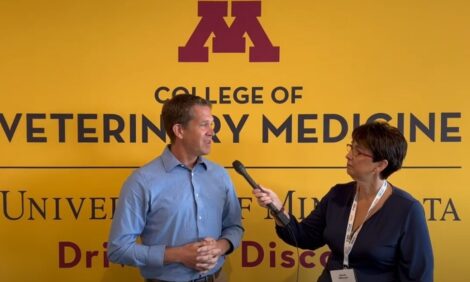



Connor: Innovation driven by necessity and opportunity
The pork industry has had a tremendous number of innovations over the years, said Joe Connor, DVM, in an interview with Pig Health Today. Connor, who serves as a consultant within Carthage Veterinary Services, is a pioneer in pig production and has been involved in innovation projects for decades.
He pointed to segregated production flow and improvements in facilities, including filtration. He noted improvements in diagnostics by moving from individual pig sampling to the use of oral fluids and processing fluids.
“Innovation will continue and we’ll see it in all areas, driven by necessity and opportunity,” he said. “The speed of innovation in all areas is accelerating.”
Connor spotlighted eight areas of innovation the pork industry is either experiencing now or will see in the future.
1. Practical slat-level innovations
The practical day-to-day collection of information is an opportunity to innovate, including factors like temperature, humidity, pit levels, and gas and water usage, Connor said.
“This information would then be overlaid with growth performance and mortality/morbidity,” he said. “That does two things: It helps manage costs and expands service people over more facilities, thus allowing producers to make decisions at the pig level in real time.”
Advancements in average daily gain, feed intake, water disappearance and usage, propane disappearance, motor efficiency, pit depth, bodyweight sensing and temperature sensing will change the way farm employees perform routine and basic tasks, Connor said.
“Innovations add robustness to help monitor the system. We don’t need a perfect solution ⸺ we can use an imperfect solution to what we’re already doing today. The goal is to free up our human resources while still identifying animals that need further attention,” he added.
2. Facilities
The US may not get to the point of building 105,000-sow farrow-to-finish operations like the one Connor described in China. That particular operation has dormitories on site, along with a feed mill and processing facility to be completely turnkey.
“China’s response to African swine fever (ASF) and COVID-19 has been to go to a single-entity facility from start to finish,” Connor said.
The US is innovating in other ways, and according to Connor, “Innovation is about data integration and data management. Many of us are collecting information at the barn level and uploading it to dashboards, but the next step will be how we use that information to drive actions at the farm and system level. For example, data collection technology can identify feed outages or bin bridging that would lead to outages.
“We see data collected either in addition to the auger runtime linked to the feed-bin boot itself or to scales, which ultimately then triggers an action — even if it’s an individual line that is not delivering feed for a period of time,” Connor said.
“We’ve been hindered in the past with the robustness of sensors,” he continued. “Companies have been able to improve that robustness tremendously in recent years. As we move forward we’ll be able to maintain those sensors to collect the information we want and roll that data into separate dashboards.”
With information learned from COVID-19 with respect to particle size and flow dynamics within buildings that contribute to virus transmission, Connor said the industry is on the cusp of being able to model this information. This advancement will help producers design ventilation in new facilities or better understand current airflow and ventilation rates within a building that may contribute to pathogen transmission.
“This will change how we think about ventilation and will allow us to make changes to improve pig health by changing the environment within the building,” he said. “Fluid dynamics modeling allows for a more rapid and complete understanding of airflow patterns to optimize the design of livestock facilities and validate existing practices.”
3. Biosecurity
“We’ve seen a large step forward in biosecurity and biocontainment because of porcine epidemic diarrhea virus and now with ASF concerns, but it’s really hinged on how we think about disease introduction and practical tools to mitigate risks,” Connor said.
As an example, current methods to disinfect supplies have been less than satisfactory, but new innovations show promise. Connor said a “bio-box” can thoroughly disinfect the supplies and equipment that come onto a farm.
The industry will see more fully integrated data flow for improved herd health and production, Connor said.
“Data will incorporate diagnostics, environmental information and current health status, not only of the pigs in the building but also of the pigs in the region and area. This data will be used to drive decisions at the farm level,” he said.
“We’ll be building a signal of disease presence,” he continued. These innovations include:
- Sensing equipment will be integrated with record databases to monitor unexpected reproductive failures. “We’ll be able to look forward to predict which sows are eligible to be bred and have a high probability to farrow. This will decrease the number of non-productive sows in the system, and we’ll be able to calculate it with 95% confidence interval of model accuracy,” Connor said. “It will have a signal trigger, and we’ll know when that signal falls outside of the confidence interval.” Sensors can also evaluate room and barn environments, with alerts sent via cell phone.
- New syringe technology allows for data capture on individual treatments from birth, through product inventory control, Connor said. It allows a person to know how many animals have been vaccinated or treated, with a code on the vaccine bottle applicator, and tracks a number of data points. The technology allows for scanning of major organs at slaughter, individual pig identification and daily body temps. “Getting a large population of the pigs vaccinated with the correct dose at the correct age is very important,” Connor said. “New syringes indicate if the pig has been full-dosed, and if it hasn’t, it tells the administrator right then that the pig has not been full-dosed.”
- Diagnostics and whole-genome sequencing will also continue to move forward, allowing the industry to do additional pathogen tracing, not only within a herd but also within an area and regionally,” Connor said.
- Diagnostics will be pen-side, and a quick test will be available in the future to monitor health on a population basis.
- Sound recording and recognition will monitor health in suckling pigs and grow-finish pigs. “We know this technology can detect low-level respiratory coughs, and we can actually use that to differentiate even the type of pathogen that might be circulating in the population,” Connor said. “Interestingly, we frequently will pick up on that information before the caregiver is alerted that it’s really a problem.” Earlier this year, sound recordings picked up a cough in a group of pigs that were under surveillance, which resulted in earlier treatment.
- “With all of the research going into the microbiome of the pig as a whole, there will be advancements to help us control parity-1 immunity,” Connor said. “Immune-system stimulation of the parity-1 population will allow us to look at microbiota and provide the vaccines and delivery mechanisms.”
4. Reproduction
Future innovations will allow producers and practitioners to monitor unexpected reproductive failure in sows predicted to farrow, Connor said. Synchronization of estrus, estrus detection, farrowing synchronization and timed single insemination can improve reproductive performance.
“We haven’t put them together to capture all the value, but that will change,” Connor said.
“Electrical impedance spectroscopy can be used to predict estrus,” he added. “It will allow some of the other drivers such as the farrowing time to be more predictable and, thus, more tightly managed, which improves farrowing-facility utilization and potentially reduces the number of stillbirths per litter.”
Advanced reproductive technologies will allow semen sexing to reach the point of commercial validity, and additional technologies will further drive the leveraged impact of elite individuals, he said.
5. Imaging technology
Imaging technology presents great opportunities in pork production, Connor said. The ability to scan animals has multiple benefits, including yield on slaughter loads, muscle percentage and animal health.
“We’re on the threshold of one or more companies having hand-held technology that would finally allow us to do that on an individual pig basis,” Connor said. “When that is available, we will be able to link that information to the growing phase of the pig and determine if the pig is on the correct growth curve.”
Weight per day of age; diagnostics, including validation of pneumonia lesions; and sow body condition are other valuable real-time uses of imaging technology.
6. Genomics
“We’re seeing tremendous incorporation of genomics. We have access to increasing utilization of sequencing information to understand complex genetic architecture,” he said. “Gene editing delivers precision changes to unlock genetic potential for disease resistance.
“In addition, digital phenotyping increases available data on existing and new traits,” he continued. “We will have efficient and objective data on more animals and access to new traits, with objective and real-time information like structure and behavior.”
7. Human development
New technology will make it easier to monitor caregiver activity within the barn. “The pork industry is increasingly incorporating outside industries to help us understand human development within our systems,” he said.
“As an example, when we monitor people movement in the barns, we frequently find that we’re moving more pigs within the farrowing room than what we thought before,” he said. “It might be against our standard operating procedures, but it might be a normal habit that employees just fall into. Another example is walking the pens every day. When we track caregiver habits, we can tell how much time is being spent in those pens. This is an area where we can collect information and use it to derive better outcomes.”
The reduction of repeatable tasks and minimizing emotional involvement are other innovations the industry will see in human resources, Connor said.
8. Predictive modeling
Artificial intelligence will help manage intervention thresholds on the farm, Connor said. “We’ll continue to drive toward using the information that we have, but predictive models will give us those early warning signs that would then drive our decisions back to the farm level.”
“Algorithms will continually update as data flows,” he said. “Veterinarians will arrive on-site with herd data and area-specific data in hand, which will allow them to be much more predictive.
“We’ll be able to get ourselves aligned to interventions and continue to look at costs and predictive outcomes. There is a natural progress of analytic tools that can revolutionize how we manage swine operations.”
The industry is constantly evolving and learning how to incorporate new innovations to the benefit of veterinarians, producers and consumers, and Connor said the industry is on the cusp of even more improvements.
“It’s easy to look backward and say we’ve had innovation, but it’s extremely exciting to look forward,” Connor said.






